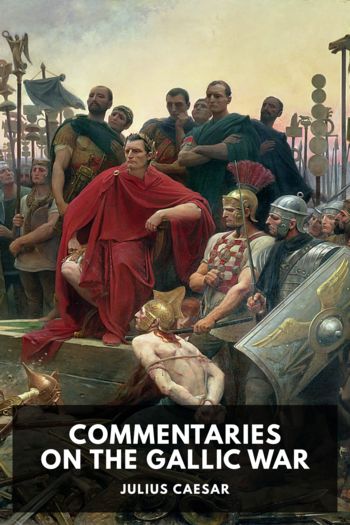Fateful Lightning: A New History of the Civil War & Reconstruction by Allen Guelzo (icecream ebook reader txt) 📗

- Author: Allen Guelzo
Book online «Fateful Lightning: A New History of the Civil War & Reconstruction by Allen Guelzo (icecream ebook reader txt) 📗». Author Allen Guelzo
Clay and Webster were acting to save a Union that they could easily see was headed for the breakers, and a Union that Calhoun was only too ready to see hit them. Day after exhausting day, Clay dragged himself to the Senate floor to defend his resolutions on the wings of words that soared far above his own personal political ambitions for the presidency. “I conjure gentlemen”—Americans North and South—to stop and “by all they hold dear in this world—by all their love of liberty—by all their veneration for their ancestors—by all their regard for posterity—by all their gratitude to Him who has bestowed upon them such unnumbered blessings … to pause—solemnly to pause—at the edge of the precipice, before the fearful and disastrous leap is taken into the yawning abyss below, which will inevitably lead to certain and irretrievable destruction.” And if the grappling sections did hurl themselves over the cliff into civil war, Clay’s prayer was, “as the best blessing which heaven can bestow upon me upon earth, that if the direful and sad event of the dissolution of the Union should happen, I may not survive to behold the sad and heart-rending spectacle.”28
One person, at least, who was moved by none of this rhetorical display in the Senate was President Taylor, and between the upper and nether millstones of Taylor and the Calhounites, the omnibus was ground to bits. When the Senate Committee on Territories finally reported out Clay’s resolutions as a single bill, its component pieces were hacked out by amendments and counterproposals, and on July 31, 1850, all but the provisions for the territorial organization of Utah had crashed to defeat. An enfeebled Henry Clay left the Senate, his political career effectively over, and sick with the tuberculosis that would kill him in less than two years; Webster returned to Massachusetts to be vilified by the anti-slavery press as a “fallen angel,” and he followed Clay to the grave four months later; John Calhoun was dead on March 31, 1850, less than three weeks after his last defiant speech in the Senate.
At this last point before the abyss, the enemies of compromise obligingly removed themselves from the scene. The death of Calhoun in March was followed by the unexpected death of President Taylor in July, and his successor, a self-made and surprisingly capable anti-slavery New Yorker named Millard Fillmore, quickly proclaimed his support for Clay’s compromise. Clay himself withdrew from the Senate after the July 31 debacle, but into his shoes stepped the junior senator from Illinois, a short, scrappy Democrat named Stephen A. Douglas.
Douglas had been born in Vermont in 1813 and half orphaned by the premature death of his lawyer father two years later. He was apprenticed to a cabinetmaker in upstate New York. At age twenty, looking for opportunities whose traces he could see only as they led westward, Douglas moved to Ohio, then to St. Louis, then to Winchester, Illinois. He set up a school, earned enough money to support a year’s law study, and in 1834 was licensed to practice law in Illinois. At a stumpy five feet four inches, Douglas was anything but imposing-looking. But he had energy in overbrimming quantities, and a chip-on-the-shoulder attitude earned him the nickname “the Little Giant.” He was a “perfect ‘steam engine in breeches,’” and starting in 1840 he was appointed to the Illinois state supreme court, elected to Congress, then elected to the U.S. Senate. He was, from the start, a partisan Democrat. Whigs were nothing but the toadies of “consolidation, monopoly, and property privilege.” Douglas was also a man with an eye for the main chance, and he saw in an alliance with Henry Clay a straight path to political stardom.29
Committed from the beginning of the debates to the principle of popular sovereignty, Douglas explained his détente with the figurehead of Whiggism as a joint project for the sake of the popular sovereignty provisions in the “comprehensive scheme.” Popular sovereignty, Douglas explained, is the principle “that each community shall settle this question for itself… and we have no right to complain, either in the North or the South, whichever they do.” Since he had never favored the omnibus approach, Douglas craftily split the omnibus bill into five separate bills and built separate congressional coalitions around each of them, with his fellow Democrats cajoled and caressed into supporting them. With President Taylor out of the way, Fillmore (in an unusual display of bipartisanship) linked forces with Douglas and pressured congressional Whigs to back the Douglas bills. By mid-September all five of them had been passed, and the substance of Clay’s compromise—if not the form—became law. “The difference between Mr. Clay’s Compromise Bill & my… Bills was a wafer,” wrote Douglas before the final votes, “and when they are all passed, you see, they will be collectively Mr. Clay’s Compromise, & separately the Bills Reported by the committee on Territories four months ago.”30
What, exactly, did this great Compromise of 1850 do? In general, it averted a showdown over who would control the new western territories, and that was the chief reason people around the country celebrated the passage of the bills with bell ringing, and in Congress with a drunken spree. In specific terms, the Compromise of 1850 allowed the Missouri Compromise to stand for the old Louisiana Purchase territories, but it established the principle of popular sovereignty as the





Comments (0)